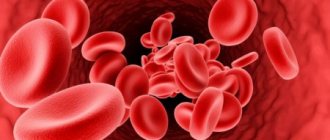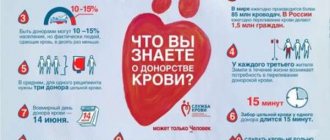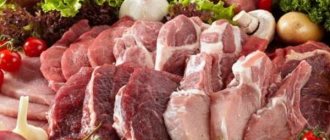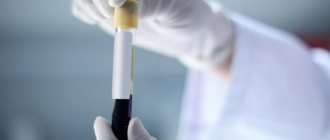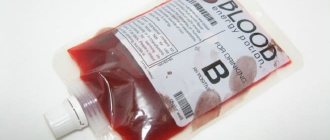Types of blood
What blood groups does a person have, how many groups are there, and the very concept of them is under the jurisdiction of the International Society of Blood Transfusion. This organization has the most complete information on all these issues. For example, the types of blood here are divided into 33 classifications, and this is not the limit.
12 facts about blood: Tsuzmer A.M., Petrishina O.L. Biology. Man and his health. Textbook. 26th ed. - M.: Education, 2001. - 240 p.
The Karl Landsteiner blood groups remain the most widely used today. At the beginning of the twentieth century, a scientist experimented by mixing blood from different donors. In some cases it folded, in others it did not. Based on the data obtained, the following blood group designation was obtained:
- 0 blood group (I);
- blood group A (II);
- B (III);
- AB (IV).
Blood groups: General surgery: textbook / Petrov S.V.
— 3rd ed., revised. and additional - 2010. - 768 p. How are blood types different? Based on practical experience, I will explain in simple words: different groups of red blood cells contain different substances on the surface. If they are not there, then the result is blood type 0. Blood type A2 is endowed with only one type, etc. The main thing that affects the blood type with this approach is the impossibility of mixing them in any combination, says WebMD. And this is a very important parameter. To find out what your blood type is, contact your healthcare provider for professional advice.
Rh factor
Another important indicator for blood is called the Rh factor. Both Rh negative blood and Rh positive blood are known for each group.
What is the Rh factor, or Rh? This is a specific substance, which is also known as antigen D. It can be present on the surface of the red blood cell, and then it is Rh+, or absent, that is, it will be Rh negative.
What does the Rh factor depend on? It is determined by heredity, just like blood type. My fellow experts carried out an analysis and confirmed: a positive indicator is much more widespread in the world, a negative Rh is not so common.
Experience shows that it does not affect the quality of blood in any way. In my work, I always take into account the Rh negative or zero Rh factor during transfusions and when pregnancy occurs.
Diet
A nutritional system based on blood type was proposed by the American naturopath Peter D. Adamo in the 90s of the 20th century and became widespread throughout the world.
Important! The meaning of the system is that due to the different interactions of blood of different groups with products entering the body, they can bring both benefit and harm to it.
Therefore, for representatives of each blood group, a separate diet should be developed that maximally satisfies the body’s needs and promotes weight loss.
Carriers of the second blood group with a negative Rh factor can boast of good adaptation to various changes in diet conditions.
Their gastrointestinal tract is well adapted to plant foods rich in carbohydrates, but their ability to absorb proteins and fats of animal origin is reduced.
General recommendations regarding diet:
- The food consumed must be environmentally friendly and clean. To select suitable products, you can purchase a tester that allows you to determine the level of nitrates. When processing vegetables and fruits, rinse them with boiled water at the final stage;
- Difficult to digest meat and dairy products should not be present in the diet. Their consumption will lead to insulin reactions, metabolism will slow down, which, in turn, will lead to the initial stage of obesity. Dairy products can be replaced with soy milk, cottage cheese and cheese;
- Wheat consumption should be limited, as it increases the acidity of muscle tissue;
- It is recommended to consume brown algae, seafood, iodized salt and spinach in sufficient quantities.
- If possible, stick to a vegetarian menu, including vegetables, cereals, and legumes in your diet every day.
The blood type diet is described in the video:
Foods you shouldn't eat
To maintain an effective diet, moderate consumption requires the following products:
Fruits
- Kiwi;
- Quince;
- Nectarine;
- Melon;
- Pear;
- Persimmon;
- Apples.
Nuts: Almonds and almond butter.
Dessert
- Jelly.
Dried fruits
- Raisin
Spices and seasonings
- Bergamot;
- Paprika;
- Rosemary.
Berries
- Strawberries
Cereals and cereals
- Rice bran
Protein products: Quail eggs.
Vegetables
- Radish.
Fish
- Halibut;
- Herring;
- Flounder.
The following products are strictly not recommended for consumption:
Vegetables
- Hot and sweet peppers;
- Potato;
- Tomatoes;
- Eggplant;
- Cucumbers.
Fruits
- Mango;
- Any citrus fruits.
- Banana;
- Papaya;
- Coconuts.
Fish: any fish that has been salted.
Sauces and seasonings
- Mayonnaise;
- Ketchup;
- Apple vinegar.
Mushrooms
- Champignon
Protein products:
- Partridge meat;
- Goose meat;
- Calf liver.
Beverages
- Orange juice;
- Black tea;
- Soda.
Table
To quickly navigate the recommendations, you can use the table below.
When choosing a category of products recommended for limited consumption for your menu, you need to carefully monitor the body’s reaction.
Reference! If, after consumption, signs of individual intolerance appear - an allergic reaction, stomach discomfort, a feeling of heaviness, you should independently move the irritant product to the category of not recommended.
| Product type | Fits | In limited quantities | Not recommended |
| Meat | White poultry meat | Everything except what is permitted | |
| Fish and seafood | Salmon, trout, perch, cod, mackerel | sardine | Flounder, herring, anchovy, octopus, crabs, oysters, squid, shrimp |
| Dairy and eggs | Chicken eggs, yogurt, bifidoc, goat cheese, kefir, cottage cheese | Milk, quail eggs | |
| Fats | Olive and linseed oil | Cod liver oil | Corn, peanut, sesame oil |
| Beans, nuts, seeds | Lentils, green and spotted beans, pumpkin seeds, walnuts, | Raw sunflower seeds | Red and white beans, chickpeas, peanuts, pistachios, Brazil nuts |
| Cereals | Sprouted wheat, buckwheat. In the form of flour: rice, oats, rye | Rice, barley, corn, couscous | White and wheat flour, semolina |
| Fruits, vegetables, berries, mushrooms, greens | Broccoli, carrots, artichoke, onion, garlic, leafy greens, parsley, spinach, figs, dates, pineapple, prunes, grapefruit, lemon, blueberries, cranberries, cherries | Beetroot, cabbage, turnip, cucumber, asparagus, avocado, apple, peach, pear, strawberry | Eggplant, tomato, potato, bell pepper, radish, banana, orange, kiwi, melon, persimmon, grapes, mango, mushrooms |
| Beverages | Water, fruit drinks, freshly squeezed juices, green tea | Coffee, dry red wine, black tea | Alcohol, sweet carbonated drinks |
| Condiments, spices | Soy sauce, ginger, mustard | Sugar, salad dressings | Mayonnaise, ketchup, apple cider vinegar, pepper, starch |
Does blood type change?
Blood type is a stable indicator. It is determined once and for life. There are myths that a change in blood type occurs, for example, during a bone marrow transplant. This is only possible in theory if bone marrow with different parameters is transplanted. But in practice this is not done, since the likelihood of rejection is very high.
There are no changes during life with age, or in pregnant women and after childbirth, or with transfusions. What is inherent in the body at the gene level cannot change.
Blood group compatibility
Which blood types are compatible or, in other words, which blood groups match each other? This question does not arise by chance and is associated primarily with extreme situations. In case of severe blood loss, blood transfusions are given in groups. Yes, today there are artificial substitutes, but doctors do not abandon traditional methods.
What blood is suitable for 1 positive, who is suitable for 4 blood group? The compatibility of blood groups during transfusion is as follows:
- people with group 1 are universal donors, their blood is suitable for everyone. But they themselves are characterized by blood compatibility only with their own group;
- for group 2, a possible combination of blood groups is 2 and 4 for donation, 1 and 4 for adoption;
- in the case of group 3, you can transfuse it to people with groups 3 and 4. These people of groups 1 and 3 take it;
- Group 4 is suitable for all blood groups. Transfusion is possible only within your group.
How does a child develop blood type b3?
In order for a child to receive this group, at least one parent must have antigen B. If the parents have different blood, it is impossible to predict what kind of blood the child will have after conception. For example, the father has the first blood group with negative Rhesus, the mother has the third blood group, while being Rh positive (diheterozygote). In this case, according to the law of independent inheritance (Mendel’s third law), either 1 group or 3 can be formed, with Rh+ or Rh-.
Rh factor compatibility
Compatibility of partners by blood type and Rh factor is an important factor during pregnancy. The fact is that with certain combinations, the mother’s body begins to react to the fetus as a foreign object and reject it. The Rh factor is associated with this phenomenon. For this reason, compatibility is checked immediately after pregnancy.
Practical experience shows how important the compatibility of parents in terms of blood type and Rh factor is. Problems occur if the mother's Rh is negative and the father's is positive. With this combination, the baby can inherit the father's Rh, resulting in a conflict in the woman's body.
Pregnancy
Group affiliation for the course of pregnancy does not play a special role, but the absence of the Rh antigen can create a lot of serious problems. The only exception is when both the expectant mother and the expectant father are Rh negative, and she has not previously had births or abortions from a Rh positive man, that is, if Rh antibodies have not formed in her blood.
But this does not mean that the unborn child also has negative Rh, because it is inherited according to the laws of genetics 1:1, that is, in 50% of cases. This protein, penetrating into the mother’s body through the placenta, contributes to the gradual production of anti-Rh antibodies. Antibodies necessarily interact with the antigen and Rh conflict occurs.
A planned pregnancy is a serious step. In preparation for procreation, spouses must undergo a short examination, as a result of which serious chromosomal abnormalities can be identified.
What is the characteristic of 1 negative blood group - quite rare among people around the globe. It will be interesting to know the characteristics of its owners. What kind of character do they have, what health problems may arise.
The rarest blood type
Scientists O.V. Gribkova and A.V. Kaptsov (Samara Humanitarian Academy), the most common classification of blood groups in the world is called the AB0 system.
In general, on the planet the number of people with different blood groups is as follows:
- about 41% of the population are endowed with the first group. It is especially common in South and Central America;
- in second place is group II with a figure of about 32%, which is typical for Europeans and residents of North America;
- people with group III occur in 22% of cases, mainly in Asia;
- Group IV is recognized as the rarest with an indicator of 5%.
Colleagues in Russia and Kazakhstan confirm that group 4 is extremely rare. For this reason, it is necessary to stock this blood and encourage rare donors to avoid problems with timely provision of medical care.
How to eat healthy
For people with blood type B, the following foods are considered useful:
- dairy: kefir and low-fat yogurt;
- from vegetables - carrots;
- fish - low-fat salmon;
- fruits: papaya, grapes and bananas;
- meat: beef liver.
Preference should be given to lean meat, foods containing fiber (rice, oatmeal) and eggs. Cereals can be eaten either cooked in water or milk. Healthy drinks include: green tea and rosehip decoction.
Prohibited: coffee, alcoholic beverages and black tea. It is undesirable to consume foods such as:
- tomatoes and juice from them;
- pomegranate;
- seafood: shrimp, anchovies, etc.;
- sauces: mayonnaise and ketchup;
- meat: pork, chicken;
- wheat bread;
- sweets.
One of the characteristics of blood type 3 is that its carriers do not need to go on any diet. There are no problems with choosing foods: both plant and animal foods are suitable for this type of person.
Most common blood type
My colleague Alexander Kurenkov in his book “All about blood. Hematopoietic system" indicates that the first is considered the parent for all blood groups. Perhaps for this reason it occupies a leading position in prevalence in the world. More than 40% of the population across the planet - be it in Russia or Kazakhstan - are endowed with it.
Still, it is worth noting some ethnic and national features. So, in Europe and Ukraine there are many people with the second blood group. And in Japan, the rarest group, the fourth group, has become widespread.
Universal donor
Red blood cells: Tsuzmer A.M., Petrishina O.L.
Biology. Man and his health. Textbook. 26th ed. - M.: Education, 2001. - 240 p. Which blood group can be transfused to everyone? Compatibility of blood groups during transfusion contains the term “universal blood”. Blood transfusions into groups are always carried out taking into account their classification according to the AB0 system.
Which blood type suits everyone? Have you ever wondered what blood type a person is a universal donor? These benefactors, who can come to the aid of one and all in a critical situation, include people in the first group. Their red blood cells do not have antibodies that another body identifies as hostile. Other blood groups, the transfusion of which is also possible, cannot be donated to everyone.
If you want to help and become a donor, contact a medical institution to find out your blood type, and then tell the doctor that you want to do a good deed.
Nutrition
Since representatives of the second negative group were originally farmers and not hunters, their diet is vegetarian in nature. This does not mean at all that they are not carnivorous and meat dishes are not recommended for them. It’s just that practice shows that their health is better when plant foods predominate in the diet.
They are recommended to take any cereal porridge and dishes made from legumes, a lot of vegetables and fruits, herbs rich in vitamins and microelements, especially those containing potassium - pumpkin, bananas, apricots, carrots, beets, peppers, dried fruits. It is better to limit potatoes and take them boiled with the peel (in their “jacket”). All this has a positive effect on the heart and stimulates the immune system, cleanses the body in case of allergic and autoimmune diseases. Protein balance can be replenished with fish and seafood dishes. It is recommended to limit meat dishes and animal fats, which will not improve the health of the vascular system.
Here are the foods that are strongly recommended not to be consumed:
- fried, smoked meat, it is better to prefer boiled beef, turkey, lean chicken;
- high-fat dairy products, butter and sour cream, it is better to replace them with vegetable oils, low-fat kefir and yoghurts;
- fresh white bread, pastries, confectionery, chocolate, candies.
Also study the diet for negative blood group 2 in addition to the current article.
Drinks containing caffeine (black and red tea, coffee) are allowed in moderation to stimulate blood circulation, improve blood circulation and relieve tension.
We also recommend studying this topic:
What blood type will the child have?
Character by blood type
Blood type determines many characteristics of the body, such as eating habits and susceptibility to certain diseases. Are blood type and character related? The following assumptions are based on my personal experience:
- the first blood type - the character of a typical extrovert, a very sociable and creative person, self-confident, a born leader;
- second blood type - the character corresponds to a serious and reliable person who is careful in everything, loves peace and tranquility, but is also endowed with artistry;
- the third blood group has developed traits such as independence, devotion, willpower, and endurance;
- people with the fourth group are responsible and caring, showing reliability along with shyness and modesty.
Does Rhesus affect personality and will 1 negative and 1 positive blood group differ in this aspect? The character on this basis does not change, because it is determined by many factors, and rhesus will not be decisive here.
Blood transfusion
People who have the rare negative blood type are the safest donors. This is due to the fact that in this case there are no antigenic properties. Thus, if there are no donors of the same group, it is possible to transfuse it in various life situations to people with different characteristics. In this case, the Rh factor has absolutely no significance. It only affects the compatibility of a man and a woman when trying to conceive a child. It is worth noting that such transfusions are not planned.
